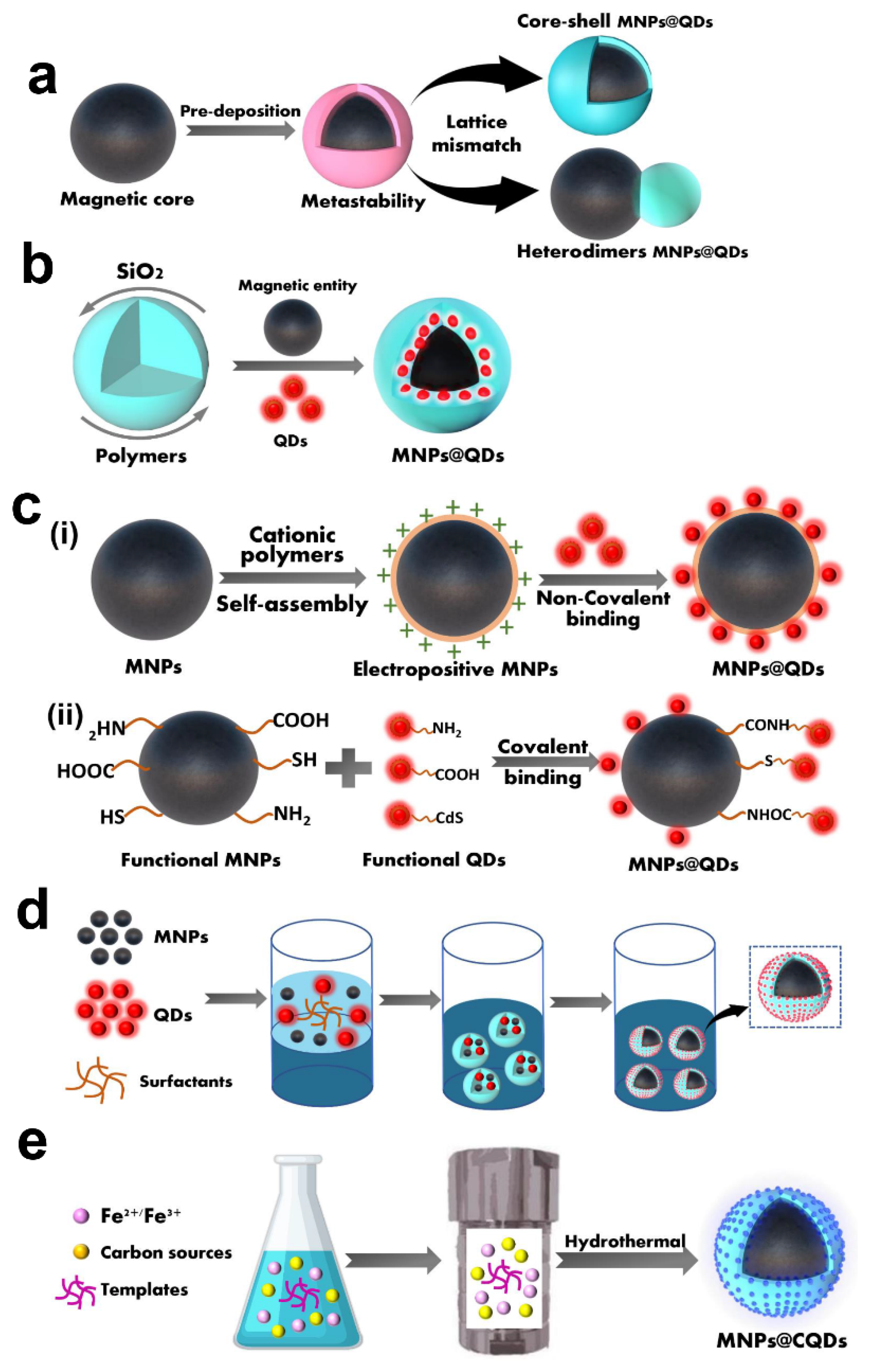The one-pot method is to mix the precursors of MNPs and QDs in a vessel to complete the fabrication of MNPs@QDs in a single step. The hydrothermal method is a bottom-up strategy under high temperature and pressure and is frequently used for preparing MNPs@QDs nanocomposites in one step; their scheme illustration is presented in
Figure 31e. In one study, Zhou et al. utilized graphite oxide (GO), cadmium chloride, ferric dichloride tetrahydrate, and sodium acetate as precursors and dispersed them in a DMSO solution to form a stable suspension. The mixture was then transferred into a Teflon-lined autoclave for a high-temperature reaction (180 °C for 12 h) to obtain nanocomposites
[104][65]. The individual components were well distributed with no mutual interference. The high specific surface area and abundant negative charge of GO provided more nucleation sites for loading MNPs and QDs. The assembled nanocomposites exhibited favorable magnetism intensity (44.85 emu/g) and high loading efficiency (0.98 mg/mg) for doxorubicin.
In addition to QDs, carbon quantum dots (CQDs) were also employed to fabricate MNPs@QDs nanocomposites. There are two apparent merits of CQDs to prepare nanocomposites: (i) the inherent advantages of CQDs, such as low cost, low toxicity, high surface area, abundant surface groups, favorable optical properties; (ii) the electrostatic repulsion generated by CQDs, which provides excellent colloidal stability for Fe
3O
4. Maleki et al. added FeCl
3·6H
2O, ethylenediamine, and citric acid into deionized water and poured it into a Teflon-lined autoclave for heating at 200 °C for 5 h, the MNPs@QDs was synthesized, and its magnetism intensity reached 62.0 emu/g
[105][66]. The CQDs derived from a onefold carbon source suffer a low QY, and heteroatom doping plays a crucial role in regulating the fluorescent intensity of CQD. Nitrogen-doping (N-doping) is a common method to improve QY. In the Liu et al. research, Poly-γ-glutamic acid (γ-PGA) was utilized as both a carbon and nitrogen source at the same time, and the precursors experienced heating and stirring, pH control, aging, and high-temperature forming Fe
3O
4@CQDs
[106][67]. The QY and magnetism intensity of resulting nanocomposites were 21.6% and 62 emu/g, respectively. The superior characteristics of high QY, good dispersity, excellent colloidal stability, tunable fluorescence, high QY, and strong magnetism make them an advanced probe for triple-modal tumor imaging. In another study, ferric ammonium citrate acted as an iron precursor and carbon source, and triethylenetetramine (TETA) acted as nitrogen source and reducing agent, followed by high-temperature treatment to obtain Fe
3O
4@CQDs in one convenient step
[107][68]. TETA effectively improved the adhesion of CQDs and Fe
3O
4 and gained better crystallinity. The QY of Fe
3O
4@CQDs drastically decreased to 4.6% compared with TETA-CQDs (53%). The static and dynamic fluorescence quenching of CQDs and IFE generated by MNPs conspire to cause this phenomenon. Although the one-pot method provides a rapid, simple, and economic strategy for fabricating bifunctional nanocomposites, the selection of suitable precursors is directly related to the magnetic and fluorescent properties of MNPs@QDs nanocomposites. Impurities are inevitably generated during the reaction period, which affects the separation and purification of products, and cannot achieve precise control of fluorescence and magnetic properties.

